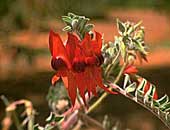

Sturt Desert Pea, named after him.

Sturts Cottage at Grange in Adelaide.
|
|
Charles Napier Sturt was born at Bengal in India in April 1795, the
eldest of 13 children of Thomas Lenox Napier Sturt, a judge. At age 5 he was sent to England to
gain an education and later became an ensign in the British army. He gained the rank of Captain
in 1825
and, with his men, escorted convicts to New South Wales in 1827.
The major settlements between Blanchetown (SA) and Gundagai (NSW) are located
on the Murray and Murrumbidgee Rivers. Both were sighted by early European settlers
as grazing lands extended west from Sydney, but their extent and places of termination
were not known.
In 1829-30, Capt. Charles Sturt and a party of men were given the task
of answering the questions posed about the waterways.
They travelled over the known tracks as far as Gundagai and then ventured
farther west. With horsedrawn drays laden with provisions, a dismantled whaleboat,
and a small flock of sheep, they moved along the southern bank of the Murrumbidgee
to where it met the Lachlan. There they encountered high reed beds and soft,
moist ground which prevented further progress by land.
The whaleboat was assembled and a party of eight embarked on a journey
to continue farther along the course of the river.
On Jan. 14th. 1830 they were swept into the junction of the Lachlan and
Murray Rivers through a sudden narrow flow at the Lachlan mouth.
The following week they saw, and spent time exploring, the lower reaches
of a large new stream which entered the Murray from the north. Sturt correctly
guessed it was the River Darling, thereby realising the network of streams which
form Australia's largest river system.
Although supplies were running low they continued along the Murray reaching
its outlet at Goolwa on Lake Alexandrina in South Australia on Feb.9th. 1830.
After 3 days of exploration they began the return journey upstream. The
task was long and arduous rowing against the flow, and when they finally reached the depot
they had previously established at the junction of the Lachlan, it was deserted. For
17 more days they continued upstream, finally abandoning the boat and pitching
camp near the present site of Narrandera.
Two of the men were dispatched to find help. They returned a week later
as the last of the provisions were exhausted.
The findings of the expedition enabled squatters and their flocks to more
confidently move westward, extending the area of European habitation, and initiating
the townships through which present day travellers pass.
In 1839 he was appointed Surveyor General and moved to Grange, a seaside suburb of Adelaide.
In August 1844 Sturt led an expeditions into the north east of South Australia
in an effort to confirm a suspected inland sea but was thwarted by bad weather and
harsh conditions. A later attempt was cut short due to his health. Neither was memorable
although he passed the site where Broken Hill now stands and explored the north west of
NSW in what is now known as the Sturt National Park. He journeyed west from there through the
Simpson and Sturt Stony Deserts before turning south towards Adelaide.
He later returned to England and died there in June 1868. He was posthumously knighted as a
member of the order of St Michael & St George.
The area where his cottage exists is now known as the City of Charles Sturt, There is a Charles
Sturt University in New South Wales, the Sturt Highway between Adelaide and Wagga Wagga, the
Sturt Desert Rose is the floral emblem of the Northern Territory and the Sturt Desert Pea is
the floral emblem of South Australia. There are several monuments to his memory and a large
desert in northern South Australia is named after him.
|
|

